Brief

A structural upheaval is brewing in corporate and investment (C&I) banking. Banks are contending with new digital technologies such as block chain, lower cost structures, shifting client demands and infiltration of new competitors. In combination, these trends threaten to shrink banks’ profit pools and challenge the viability of existing business models. Yet bankers have been distracted by regulatory changes and an extended trough in the economic cycle, which have reduced the industry’s return on equity (ROE) by 30% to 40% since the global financial crisis began.
These technology-led disruptions raise existential questions for banks. Will C&I markets be attractive and profitable a decade from now? If so, what role will different types of banks play in a rapidly evolving market structure? And what must they do to deliver acceptable returns on capital throughout the economic cycle?
Alongside the task of managing for the next quarter, then, lies the challenge of determining the right long-term ambition for the bank and plotting the path toward it. This involves hard choices about where to focus, where to cut back and what it will take to succeed in the future. Many C&I banks, especially in Europe, feel stuck between a rock and hard place, as either cutting back or investing for the future will likely worsen their already weak financial performance in the near term. However, banks that focus too much on near-term results, hoping that flush times will reemerge with the next turn in the economic cycle, stand to face even tougher challenges down the line.
Structural shifts in the C&I market
These shifts in the C&I landscape will likely play out on the following fronts (see Figure 1):
Transaction banking. Why, in the age of instantaneous digital transactions, does settling a cross-border payment take hours or even days? The answer lies mainly in the legacy practices of banks that have operated the world’s payment systems, but these methods are on the verge of being swept aside. Technologies such as block chain will help replace such outdated practices in payments and trade finance (as well as in securities and derivatives clearing)—whether it takes two years or 10 (see Figure 2). Such technological advances will fundamentally change the cost and pricing structure of corporate and institutional banking services.
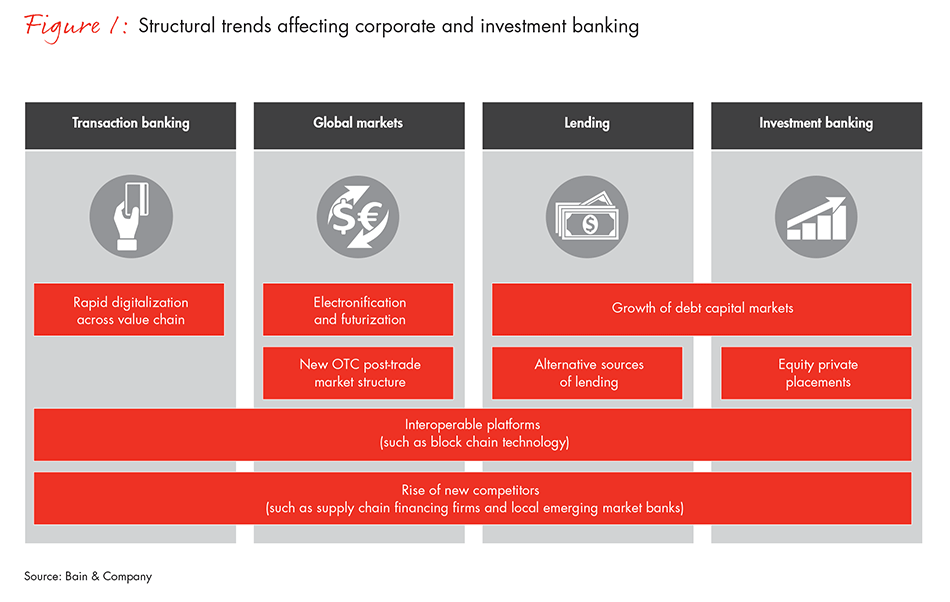
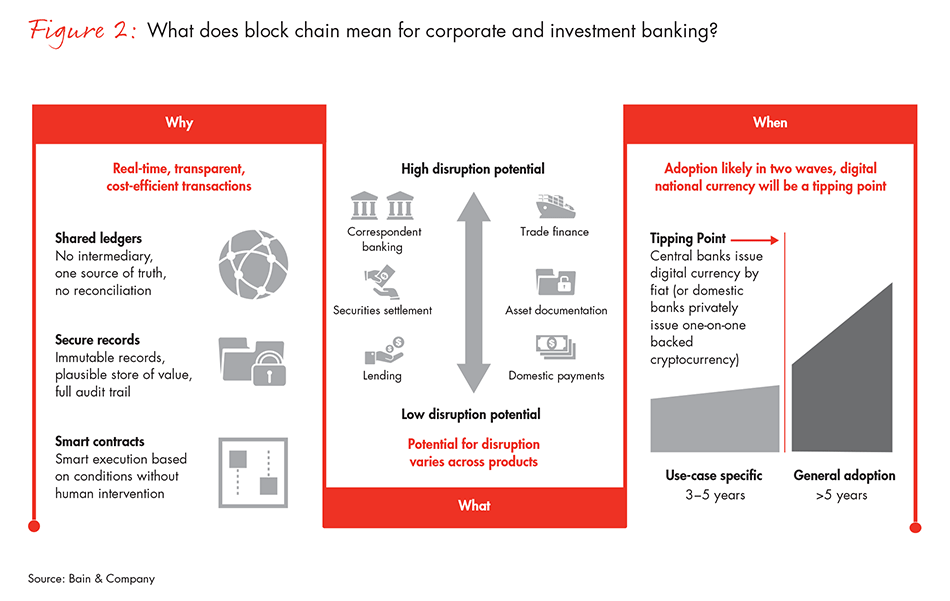
The eventual development of digital national currencies, such as Fedcoin, could eliminate the need for some of the activities banks do today.
In other areas besides payments, the gap has widened between what clients need and what traditional banks offer. Corporate clients want faster, more transparent, efficient and integrated transaction solutions, with harmonized standards between banks, according to the latest survey by the Association for Financial Professionals. Clients have been seeking portals from vendors such as Misys and Kyriba to manage multiple banking relationships. These portals are being developed to serve as an aggregator platform for corporate treasurers. Clients also indicate that they increasingly want advanced analytics to optimize the financial and operational management of working capital and supply chains. And they want tighter connections to their corporate IT systems and across the participants in their supply chains.
While most banks understand these needs, some have struggled to adapt, in part because their legacy IT systems make it difficult to accommodate integrated solutions, and modernizing them is both costly and difficult. That puts them behind a few banks that have moved faster to modernize their IT platforms, and it opens the door to alternative providers with more agile, cloud-based approaches (see the sidebar, “A field guide to digital attackers”).
Global markets. Increased regulations and restrictions in global markets have eroded the return on capital for most banks, and their competitive position in this area may become even more tenuous, as only a few banks will be able maintain sufficient scale and capabilities. For example, electronic trading platforms continue to expand, compressing bid-ask spreads and requiring substantial investments in technology.
Futures and other standardized contracts traded on exchanges or other trading venues pose another threat to the traditional over-the-counter (OTC) profit pool. Commodities, fixed-income, and foreign-exchange (FX) asset classes generally are following the evolution of equities. “Futurization” is now growing in prominence in commodities, for example, with the number of exchange traded commodities derivatives globally growing at roughly 16% per year over the past decade, according to the World Federation of Exchanges.
Asia represents the region with the largest growth potential in traded markets, and the structures of Asian markets will likely feature significant innovation. China and India, for instance, have gained ground in exchange-traded commodities futures (see Figure 3). These markets will gain scale in a technological and regulatory context that is quite different from what the US or Europe experienced several decades ago. They may leapfrog practices in the West, just as China already has in peer-to-peer consumer payments; this has also occurred in Brazil and Korea. The latter two countries developed primarily exchange-traded market structures in FX and rates derivatives, compared with the older and primarily OTC market structure in the US and Europe.
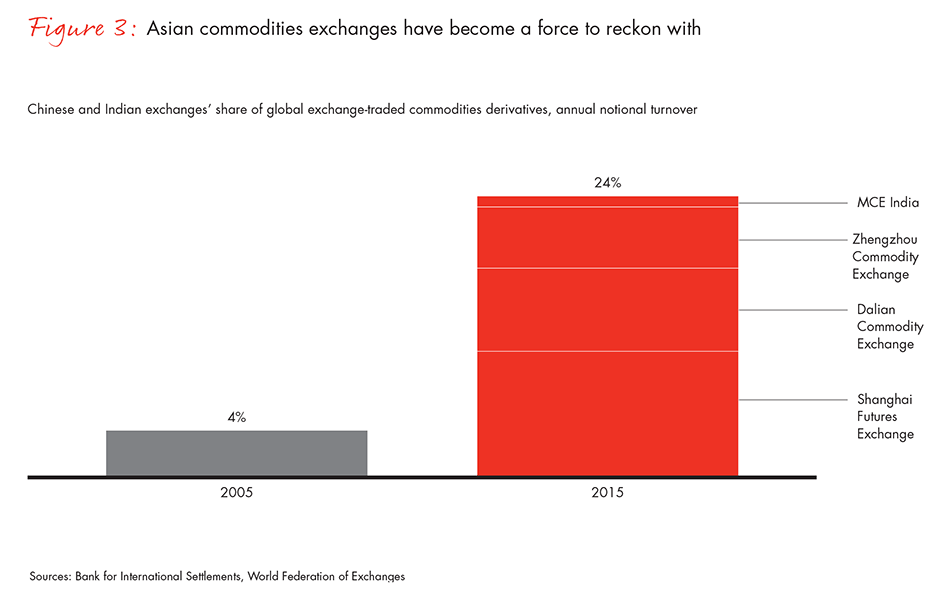
Another threat consists of new post-trade market structures within the OTC market. Legislation such as Dodd-Frank and the Markets in Financial Instruments Directive (MiFID II) have mandated central trading platforms and clearing houses. In credit default swap markets, the share of outstanding contracts cleared through central counterparties (CCPs) rose from 10% in 2010 to 31% in 2015. These CCPs will chisel away at the profit pool in what remains of bank-underwritten OTC swaps, due to reduced counterparty risk on the part of non-clearing member banks and the pricing pressure that follows increased transparency.
Lending. Although lending comprises a significant part of the revenue pool for the average C&I bank, alternative sources of credit, mainly through debt capital markets, have grown steadily. In the US, debt capital markets for large companies now provide more than 50% of corporate credit. A similar shift is starting to occur in Europe, where, until recently, debt capital markets made up less than 20% of total corporate credit. In large emerging markets such as Brazil, China and India, bank lending still dominates corporate credit, but there could be an accelerated shift to debt capital as these countries open up their markets. In China, for example, corporate financing from debt securities, starting from a small base, has grown at 50% annually over the past decade, which is twice the growth rate of bank financing, according to data from The Bank for International Settlements and the OECD.
Fresh competition also comes in the form of private equity funds, private placement firms and hedge funds that selectively provide direct lending to companies. KKR has raised more than $5 billion in direct lending funds. Lufax in China is developing distribution of corporate debt to investors over its exchange platform.
New technologies and a shifting marketplace are bringing structural upheaval to corporate and investment banking. Thomas Olsen, a partner with Bain's Financial Services practice, discusses the different paths to success.
Investment banking. M&A and primary capital markets, while relatively small, generate a lot of value and high returns for most banks. And advice will likely remain bespoke rather than commoditized, for the near and medium term. Yet structural changes are affecting investment banking as well, ranging from intensifying competition from boutique advisory firms to the emergence of private-placement markets such as Nasdaq’s. Through such markets, startups now have more financing options. They can use private placement to raise and trade equity, two developments that could delay initial public offerings (IPOs) and affect the underwriting revenue pool of investment banks. This has already happened with many of the US technology “unicorns” (private companies valued at $1 billion or more).
The waves of changes described above threaten banks’ traditional sources of strength. The rise in capital requirements, regulation and new competition enabled by technology have compressed C&I profit pools and returns. These new competitors have demonstrated that balance sheet risk taking is not limited to banks and that proprietary technology solutions no longer give banks an advantage. Worse, the banks risk fragmenting their client relationships, as the balance of power begins tilting toward clients who have access to much more transparent information. Some clients, for instance, are starting to bypass banks and directly manage their own transactions and the financing of their supply chains.
Granted, the pace of change varies across geographic markets, with Western European banks currently suffering the most damage. Even in the faster-growing Asian markets, many C&I banks are struggling with declining returns on capital and increasing regulatory requirements. In response, established banks are redrawing boundaries, such as global banks retreating from deep local participation in Asia due to the rising compliance costs and risks in markets where they have smaller operations. This allows local and regional banks in Asia to build their presence while also strengthening their capabilities to serve more sophisticated clients. These banks are actively investing in C&I talent and technology and clients have noticed. Greenwich Associates’ survey of corporate banking clients shows a significant narrowing of the quality gap between local and global banks over the past two years.
Making explicit choices to reposition the bank for the future
In all regions, banks will need to make hard choices today in order to configure a stronger position for the future. These choices will be informed by how well they understand their customers’ priorities, the new technology that is changing the market structure, the economics of their chosen activities, and the bank’s ability to maintain or strengthen those capabilities that will be critical for success. The choices cluster at three levels:
- Defining an explicit ambition in serving the C&I market. The fundamental choices in setting ambition will depend on a bank’s starting position, capabilities and appetite for risk in this evolving market.
- Choosing where to play across client segments, products and geographies—whether that means expanding the core into adjacent markets or paring back to focus on fewer opportunities where the bank has more sustainable advantage.
- Taking a deliberate approach on how to win by building truly differentiated capabilities where it matters most.
Depending on the markets they compete in and their business models, banks face different strategic dilemmas at each of these levels. We have categorized six broad models based on a bank’s product and geographic coverage (see Figure 4).
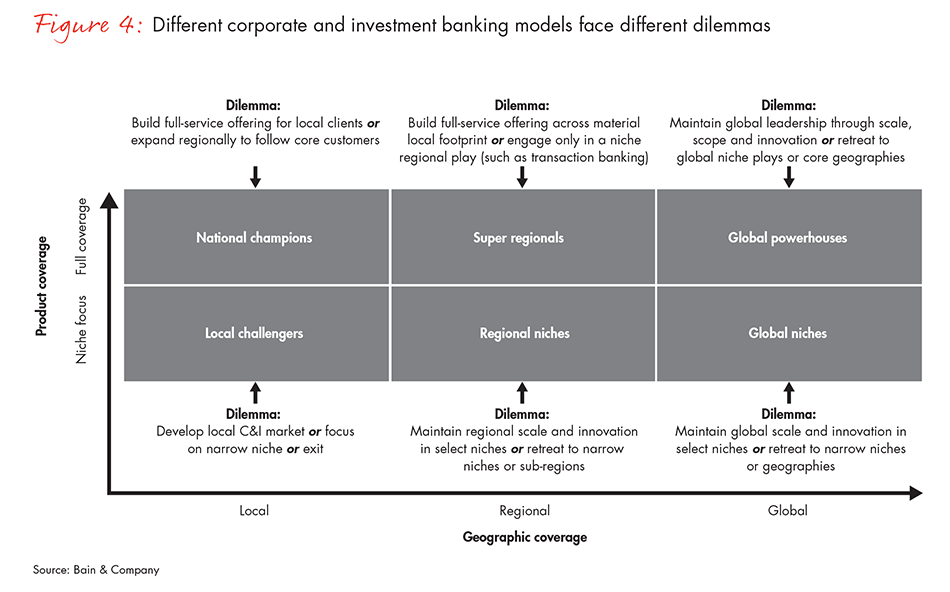
Apart from their different business models, banks’ situations also vary depending on the nature of their geographical footprints. A developing country in Asia has very different characteristics compared with a large developed country in Europe. The general trends and direction will be similar, but the pace of change will vary significantly by jurisdiction.
Even in fast-growing Asian markets, for instance, many C&I banks struggle with declining profitability. Global banks have been retreating from deep local participation due to the rising compliance costs and risks in markets where they have smaller operations. This allows local and regional banks to build their presence while also strengthening their capabilities to serve more-sophisticated clients (see Figure 5).
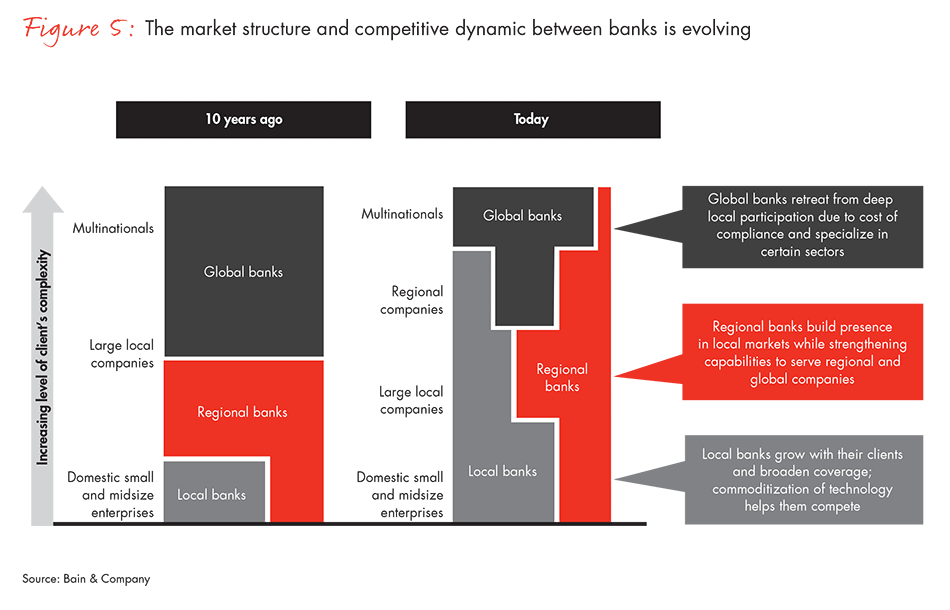
In choosing tactics to execute the strategy, three capabilities should be considered as table stakes in C&I banking: strong regulatory management, a client-centric approach to offering solutions, and advice and advanced technology management to support client needs. Banks will need to make tough choices regarding what other specific capabilities to invest in—ranging from derivatives trading teams and IT platforms to trade finance processing operations—and which they should avoid, outsource or serve through white label.
Let’s look at how the choices play out for three banks with different business models and market situations.
A national champion in developing Asia. This type of bank has growing revenues but declining return on capital amid a corporate-lending-heavy portfolio. As global banks retreat from the region, the bank sees a void where it can establish a stronger position in fee-based products. By adopting the latest vendor-sourced technology platforms, it can catch up to or even leapfrog the older platforms of many larger regional and global banks.
Its ambition is to expand beyond being a full-service local bank to become a regional C&I bank that can follow its corporate clients as they expand their businesses and supply chains regionally.
Choices about where to play increasingly center on credit relationships as a form of “loss leader” hook for clients, in order to expand into transaction banking and products such as FX and FX hedging linked to trade, which generally have higher returns than lending. Target clients include local corporations that have cross-border needs, such as consumer goods and industrial companies that are expanding across Southeast Asia.
This bank has confidence it will win through the strong client relationships it has built on its long-standing reputation as a trusted adviser. It has hired and developed high-caliber local talent, at the right level of seniority and with the soft skills required to provide clients with a holistic perspective on all products, not just lending.
To support those relationships, it will need to adopt an open architecture and agile IT product platform that allows the bank to stay competitive as a one-stop-shop for most core corporate banking needs. The rapid development of vendor-provided product platforms leads to a commoditization (or democratization) of basic product capabilities. This makes it possible for a local bank to increasingly source global best-practice platforms through vendors, white-labeling or even outsourcing. This evolution resembles an open-architecture wealth management model, which provides access and advice but not the ability to manufacture products if a bank lacks the required scale or capabilities.
A super-regional European bank. This bank has seen a dramatic contraction in its profit pool, especially for global markets. With competitors battling for a shrinking pie, and regulation raising costs, the bank faces two difficult options: maintain global or regional scale and innovation in select niches, or ramp down or exit a significant part of the current business. Neither choice presents an attractive near-term option for shareholders.
The bank has a strong local corporate client franchise and well-established positions across Europe. These relationships are grounded in credit, which does not provide an attractive return. The fee-income products the bank once relied on have come under significant pressure from competition and from clients’ greater focus on transparency, price and efficiency.
The most logical battleground for the bank to compete for fee income would be the global markets business and transaction banking. However, the bank cannot currently compete with first-tier competitors in these products. Although the bank is investing in technology, it will take several years to modernize the IT architecture. As a result, the bank likely will not have the resources or appetite to invest that can compete with the tier-1 banks.
Therefore, it chooses to narrow its focus on a core set of clients and geographies and to invest in the ability to quickly follow market leaders through vendor-provided and outsourced solutions for basic products. It will differentiate itself from competitors through a deep understanding of its clients, strong client relationship capabilities and tools, and by providing excellent client experience and service through multiple channels.
A global powerhouse. Facing a new regulatory regime and long-term technology trends that reduce profit margins, this bank recognizes that only a few large-scale competitors will survive, much less thrive. As a result, it must decide whether to maintain global leadership through scale, scope and innovation, or whether to selectively retreat to global niche plays or core geographies.
That dilemma extends to its choices about where to play. Investment advisory and primary markets will continue to be attractive and less consolidated than secondary markets. On the other hand, much of the global markets business will continue to be unattractive for all but a handful of global leaders that can maintain sufficient scale. The same will increasingly be true for the most sophisticated global transaction banking services.
To win with a global investment banking business model, the bank will have to ensure that its local and regional footprint matches clients’ priorities; that it has exceptional advisory capabilities; and that it is able to invest to build sustainable scale and capabilities to have the most efficient platform across a broad set of product areas. Without sufficient scale and scope, global banks cannot maintain expertise across their chosen geographies and industries, achieve capital efficiency to back their risk taking or keep up with compliance requirements.
***
How will established C&I banks fare? They have major strengths that continue to serve them well. Corporate clients still seek trusted, experienced partners with whom they can develop a long-term relationship (see the sidebar, “Relationships prevail, despite the rise of the machines”). Regulators and market infrastructure providers also seek to work with trusted and experienced banks. Change in institutional markets tends to come through evolution rather than revolution. Banks can build on these institutional strengths to evolve their business models, but they will need to adapt faster and evolve both their cultures and operating models to be able to manage through significant changes at pace in the new, more technology-driven environment.
Banks that do not grasp the structural changes rolling through C&I markets, or that focus too heavily on managing through the current cyclical and regulatory pressures, risk falling further behind. Those that acknowledge the profound shifts that are under way—and begin to adapt their organizations now—stand a better chance of defending and even expanding their franchises.
A field guide to digital attackers
Digital attackers have emerged in C&I banking, particularly in the transaction business. There are three main types:
Aggregators address corporate managers’ desire to have unified access to all their bank relationships. For example, Misys financial software provides a multi-bank corporate treasury management system that links all global cash positions, risk management and real-time bank account status. Fintech startups are also targeting the global markets space with aggregator models to streamline access across asset classes and trading venues.
Innovators serve as intermediaries, reducing a bank’s role in processing or funding. Cross-border payments (for faster, real-time payments by the likes of Earthport and Ripple) and supply chain financing (provided by firms such as PrimeRevenue) have been their main niches.
Disruptors look to replace banks altogether, through new technology or alternative business models. Examples include private equity firm KKR and China-based peer-to-peer lender Lufax.
Banks have responded to these three types of digital attacks with their own versions of technology-led solutions. Société Générale launched a supply chain solution in partnership with Kyriba. And PNC announced a partnership with OB10 (owned by Tungsten) to offer customers expanded automation of the procure-to-pay process.
Relationships prevail, despite the rise of the machines
The march of digitalization in C&I has not rendered bankers obsolete. Indeed, when Bain & Company interviewed executives at banks’ client companies, they cited relationship management as the most dominant factor in recommending their “core bank.” They value responsiveness, a proactive approach and stability of the bank’s coverage. To excel in relationships, banks will need to invest in frontline talent, mobilize the right sector and product specialists in the right place at the right time, and embed the client’s perspective into the chosen strategy.
Banks that build high-quality relationships and earn their clients’ advocacy benefit from superior economics. That’s because clients who are promoters of a bank do more business with the bank and often cost less to serve. On average, they generate double the value of clients who are passives or detractors.
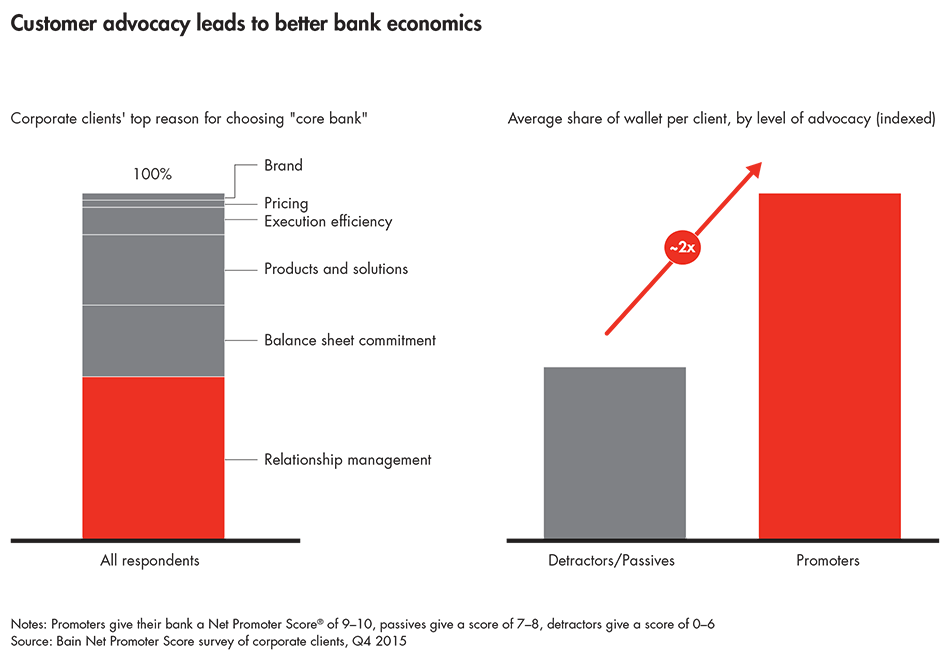
Net Promoter®, Net Promoter System®, Net Promoter Score® and NPS® are registered trademarks of Bain & Company, Inc., Fred Reichheld and Satmetrix Systems, Inc.
Thomas Olsen, Ada di Marzo, Jan-Alexander Huber and Joe Fielding are partners in Bain & Company’s Financial Services practice. They are based, respectively, in Singapore, Paris, Frankfurt and New York.





